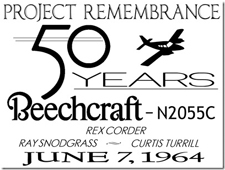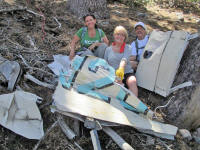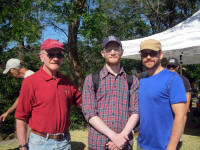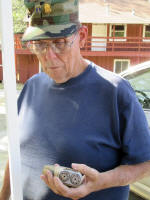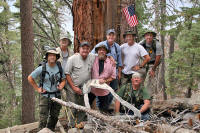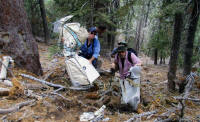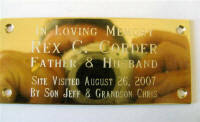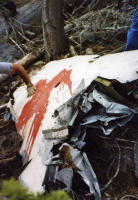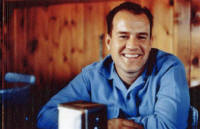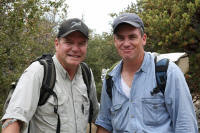|
Aircraft Wrecks in the Mountains and Deserts of the American West Beechcraft Travelaire
N2055C
Watch this
accompanying video! Whenever a beloved member of a family dies suddenly, and tragically it can be overwhelming for those left behind. No matter how the grieving process goes there are often long term problems that arise for the survivors especially for the children of the deceased. The facts about any aircraft accident are just one part of the story. These facts are preserved in the archives of the various military service branches or in the case of commercial or private plane accidents they are kept by NTSB, but for those left behind, however, they are stored in the most private places of the heart. When I was contacted by Jeff Corder about the crash that claimed his father’s life on 6/8/64, I was immediately taken back to my first visit to Jeff’s dad’s crash site. This was in the summer of 1965 while I was working at YMCA Camp Conrad in the San Bernardino Mountains of Southern California. I recalled a fairly steep assent through a forest of Jeffery and Ponderosa Pines. I took few photos in those days, but I remembered loose rock and some hard scramble conditions. When Jeff asked if I could help him reach the crash site I could not refuse. I had returned to the accident scene in the summer of 1967 with my wife Mary Jane who was then pregnant with our first child Patric Joseph. She remembered the climb as no big deal, and encouraged me to help Jeff Corder get there. After a planning meeting with Jeff we set a hiking date and prepared to go, but because my 1960’s hikes did not have the benefit of GPS I asked a friend Chris Le Fave to scout the site in advance so that we would be sure of success on our first mission. Chris was successful on his first try, and we were good to go. To assist in our venture I asked my son Pat, Orange County Park Ranger Tom Maloney, Eric Blehm, and Police Officer Chris Le Fave. Jeff Corder brought his nephew Chris Dillard also a law enforcement officer. We were blessed with good weather on the day of our hike on August 26, 2007. Thunderstorms had been forecast, but we lucked out as our team made their way toward our goal of visiting the crash site and placing a small memorial marker to honor the memory of Jeff’s dad Rex C. Corder. At the same time we were mindful of the other two passengers aboard N2055C, Curtis F. Turrill, and Ray E. Snodgrass who had lost their lives on that fateful day in June 1964. As we approached the wreckage of the Travelaire Jeff Corder needed some time alone to face the accident scene and the wide range of emotions that he would experience on this most challenging day. Everyone in our group was affected in some way as we climbed towards the point of impact together. Feelings ran the gamut from empathy and compassion for what Jeff was going through to hope that closure and peace would be Jeff’s at days end. There were some tears shed and prayers said by a group that only a few days before had been strangers, but were now friends high in the San Bernardino Mountains. Our group spent hours examining the wreckage of Beechcraft Model 95 N2055C the famed “Travelaire” was a favorite of businessmen pilots such as Rex C. Corder. The death of Rex and his two friends on 6/8/64 was not the fault of his well maintained plane, but on a combination of factors starting with the weather that required an IFR approach to Ontario Airport. Rex Corder was a highly qualified instrument rated pilot with an unblemished flying record that spanned more than twenty years. The defining factor in this accident was a RAPCON controller based at March AFB who misidentified and misdirected N2055C into the side of a mountain with fatal result. The CAB (Civil Aeronautics Board) found in their official report that the loss of N2055C and those on board was controller error with weather as a compounding factor. The FAA and CAB used this accident as a precedent setting case to improve aviation safety and issued a special publication available to all airmen and air traffic controllers. What might have saved Rex C. Corder and his passengers, a transponder perhaps? The transponder would probably have made the difference, but this expensive “new technology” was just becoming available for private aircraft and N2055C was not equipped with one, though Rex Corder had planned to have one installed within a few a few months. Based on the radio communications between N2055C and RAPCON we know that Rex Corder questioned the controller about the directions he was given and asked for verification of same. Being sent away from Ontario Airport by RAPCON did not seem to a good idea to Rex, but pilots tend to follow the directions they are given in IFR conditions. Choosing not to follow the controller was an option rarely acted on by pilots in these circumstances. We are all trained to follow the directives of those in authority, at times to our peril. Special thanks to Jeff Corder for supplying historical insight, government documents, and relocations of his dear dad. Thanks also to George Petterson, retired NTSB investigator and friend of Rex C. Corder who provided additional details surrounding this tragic story. Special thanks to the team that assisted in this important memorial effort.
|
|
|
